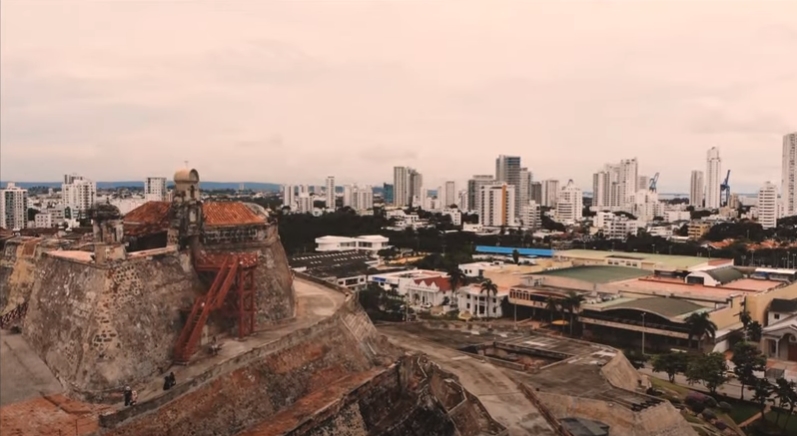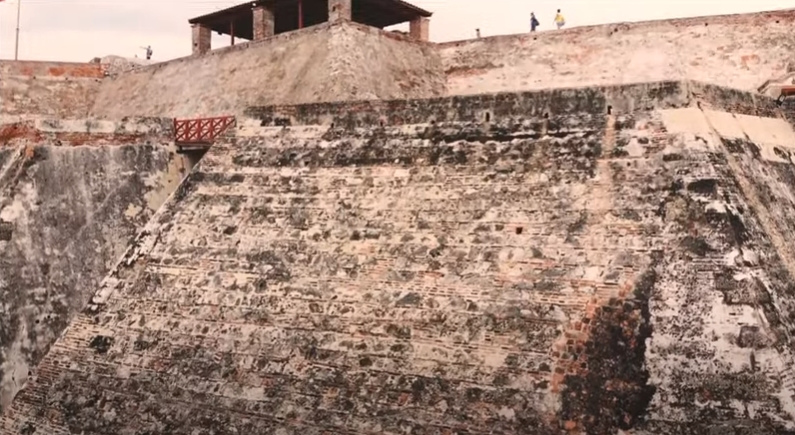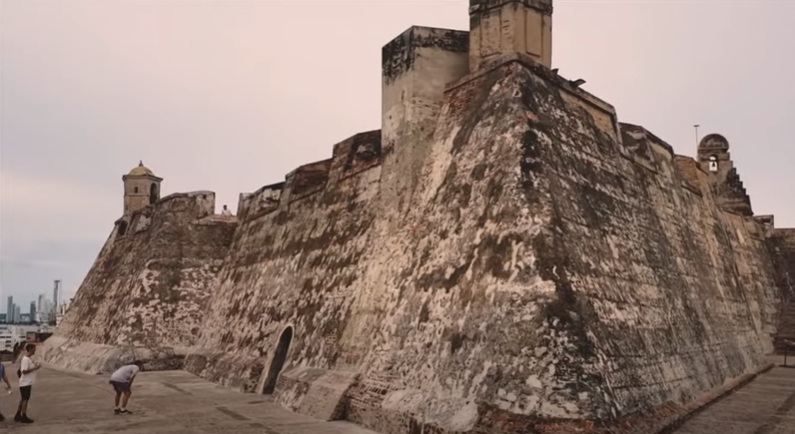The urgency to attend to the defense of the empire, seriously undermined by privateer activity.
Launched the mission of Field Marshal Luís de Tejada and the Baptist engineer Antonelli in 1587 at the express request of King Felipe II.

For Cartagena, already identified as one of the keys of the empire, a point of vital importance for the protection of the South Caribbean and of communications by the Isthmus of Panama with the very rich viceroyalty of Peru.
Antonelli designed a correct and practical walled enclosure that fits disciplined to the topographic circumstances of the site.
Bastion of Santo Domingo
It is the Baluarte de Santo Domingo around 1602, where Antonelli’s scheme begins to take shape.
On the same Avenue through which Francis Drake had entered Cartagena, Roda decides to cement the first of the great bastions.
The city did not yet have redoubts in stone and its few defenders stationed in a trench hastily laid out on the narrow isthmus that separated Bocagrande from the city.
Just where Santander Avenue passes today, they could do nothing against the invaders.
San Felipe (Name initially given) was a model of the proportions regulated by the Italian School of fortification.
The low places for the cannons that had to flank the curtains on both sides, crossing fires, on the right and left, with the small neighboring bastions of Santiago and La Cruz, were opened at ground level.

At the beginning of the 18th century
During the substantial reforms and reconstructions of the engineer Juan de Herrera y Sotomayor, the low squares disappeared, but the vaults that served as access to them still exist on both sides of the ramp.
- There are also, twenty meters to the left in the wall, the witnesses of the lintel of the walled door of San Felipe.
Don Juan de Herrera moved it to a safer place on the opposite side of the bastion, where you can still travel quietly.
Since before Juan de Herrera, the bastion had been renamed Santa María, but after all, neither San Felipe nor Santa María made a career.
The common people ended up calling him, as to the next door, Santo Domingo, for the neighboring convent that from the XU century lent its name to the toponymy of that corner of Cartagena.

Bulwark of Santa Catalina and San Lucas
Just as Santo Domingo was the key to the defense of Cartagena in the southeast, Santa Catalina and San Lucas protected them in the northeast.
- These bastions were in charge of preventing enemy access through the dangerous avenue of Cruz Grande, which today we would call El Cabrero, Marbella and Crespo up to La Boquilla.
Cristóbal de Roda always following in the footsteps of his uncle Antonelli, but adjusting himself better to the terrain.
He advances the bastions in the direction of La Boquilla leaving behind them the vacant lands that were to form the enormous orchard of the Convent of San Diego.
And palliate not a little with its fruits and the abundance of jagüeyes, the rigors of the places to which the city would be subjected.
The primitive bastions of Santa Catalina and San Lucas
One on the sea and the other on the spout of Juan Angola, flanked from their low places, like Santo Domingo.
The curtain that closed the enclosure and sheltered in its center, the door of Santa Catalina.
Completed in 1638, San Lucas and especially Santa Catalina.
Will suffer greatly from the sea and especially the blasting of the French by Baron de Pointis during the seizure and occupation of the city in 1697.
The reconstruction of 1719, like that of all damaged defenses of Cartagena, will be borne by the tireless and competent Master of Campo Juan de Herrera y Sotomayor.
As in Santo Domingo, the low squares disappear and the door to the other side of the San Lucas bastion is relocated to its current location.
The public reservoirs and their collecting channels are also repaired and it is stolen from the sea, building spurs with drawers of wood filled with stones.
A small beach that protects the Santa Catalina bastion from storms and that will be the predecessor of the land rescued from the waves where Santander Avenue passes today.

Today, after being restored by the Cartagena Public Improvement Society, the bastion is the headquarters of the Fortifications Museum.
Bulwark of Santa Catalina, Museum of Fortifications
Since December 2002, inside the Baluarte de Santa Catalina.
The Cartagena Public Improvement Society gave the Museum of Fortifications service.
The Fortifications Museum is a Site Museum, an enclosure that summarizes centuries of history, of a feverish and intense dynamic that was the construction of The Walls.
A place that will serve to make us think, think about time, think about how they were built, who built them.
Why they exist in this City where they exist and why they are the way they are.
This space not only lies answers, but questions remain, for anyone who has the capacity to be amazed at the immense human effort behind the construction of the walled city.
This interests you:
Inside the Baluarte de Santa Catalina and using its spaces such as the Casamata (underground fortification system protected by the same body of the wall).
The Escape Tunnel or Socorro (this tunnel is the only example that has communication with the exterior of the walled sector)
- The Gallery that connects the upper platform of the Bastion with the area called El Espigón de la Tenaza and the Cistern or Cistern, as an integral part of the Museum.
What we have called an Empty Museum has been implemented, where through panels the history of the construction of America’s fortifications from the 15th to the 19th centuries is presented, obeying a chronological order.
Information on the construction of fortifications in America (with emphasis on those built in Cartagena de Indias); the history of the Baluarte de Santa Catalina and its restoration process carried out between 1996 and 2000.
Biographical profiles of the Military Engineer Don Antonio de Arévalo and the Defender of the City, Don Blas de Lezo.
Information on the strategic location of Cartagena de Indias; Strategies used in the defense of the Plaza-Fuerte de Cartagena and data on the Carrera de Indias.
The incursions of pirates and corsairs and the measures taken by King Felipe III.

San Ignacio bulwark
The cannons of San Ignacio pointed towards the Bahía de las Ánimas.
The same one that today houses the cabotage traffic and that then, before the recent fillings.
Spread throughout the beach between Santander Avenue and the curtains of the city.
The small boats that served as a bridge between the galleons established in La Caleta, there in front of the Fishing Club and the Naval Base.
And the Contaduría dock, very close to the current office of the Mayor Mayor, were sailing by force.
Their mission was to cooperate in the discovery of Bocagrande Avenue.
And to discourage any attempt against the pier or against the shore of the Getsemaní suburb.
San Ignacio, originally known as the bastion of the Moors, should have been completed around 1630.
The work of Cristóbal de Roda would have to support, however, more than a legal shock in this first stage of its existence.
Indeed, on the adjoining curtain, and prior to the required authorizations, the Society of Jesus built its cloister and college on the same site that they still occupy.

The religious annexation of a military construction
on the “plaza front” to which, in addition, two small but dangerous assorted doors are opened.
Provoked one of those endless controversies that perhaps made the almost immutable colonial tranquility more bearable.
- And that is how for more than thirty years military engineers struggled to evict the Jesuits.
Even obtaining a demolition order, and they defended themselves with delaying actions, alleging lack of resources to move elsewhere.
By royal order it was also necessary to grow to San Ignacio.
Thanks to Juan de Herrera and Sotomayor, the bastion finally acquired its current dimension around 1730.
With its large baroque port and its access ramp.
Which was revived a few years ago in the course of the restoration that demolished the aesthetically ill-advised Flag Monument.
Also from Herrera’s time, perhaps its current name, San Ignacio.
Dates from the nearby church, today San Pedro Claver, which was part of the establishment of the Company.
Better of course, the saint of Loyola than some Moors to defend Cartagena where the tradition of baptizing forts and bastions with all the Santoral was well rooted.
